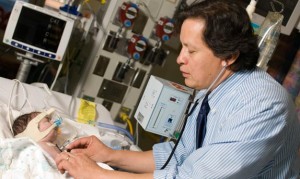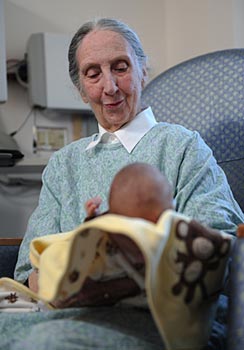
Louis Muglia, the Edward Claiborne Stahlman Professor and vice chair for research affairs in Vanderbilt’s Department of Pediatrics, has received a three-year, $585,000 grant from the March of Dimes to continue support for his work to identify genes that may predict preterm birth and help in the development of new drugs to prevent it.

This is the sixth year Muglia has received support from the March of Dimes for his work in prematurity. He is studying genes to find critical codes involved in the timing of delivery; codes that might help explain important mechanisms involved in all deliveries.
“We are using a new approach that we did not have the capacity for previously. This is one opportunity to bring personalized medicine into women’s health and pregnancy health,” Muglia said.
“I am delighted and grateful to the March of Dimes for their continued generous support of Lou’s extraordinary research program. He has placed Vanderbilt at the center of research in prematurity and I am certain his collaborative efforts will lead to healthier lives for our children,” said Jonathan Gitlin, James C. Overall Professor and chair of pediatrics.
Genetic sequencing

Muglia is examining the genes in a cohort of 20 Finnish mothers who have strong family histories of preterm birth. The Vanderbilt Genome Sciences Resource (GSR) will sequence their “exomes,” or the expressed portions of their genetic code, to identify the candidate genes most strongly associated with preterm delivery in this group.
Then the exomes will be compared to those of women with preterm birth in the United States. Muglia is hoping to target genes that produce physiological signals involved in the timing of both full-term and premature delivery.
“We would like to have a high level of confidence that the genes we identify are involved in the timing of birth to enable us to identify women at high risk of early delivery. It could also allow us to develop preemptive treatments for these women,” Muglia said.
Studying prematurity
Muglia is one of five scientists whose work is supported by the March of Dimes Prematurity Research Initiative (PRI). The 2011 grants total almost $2.4 million. The program, which began in 2005, has distributed nearly $20 million to find new treatments for preterm birth, which remains a leading cause of infant death in the United States.
“New research is critical if we hope to continue the recent two-year decline of our nation’s preterm birth rate,” said Jennifer Howse, president of the March of Dimes. “We’re proud to continue our support of long-time grantees such as Dr. Muglia, with the hope that he will build on what we already know about the causes and prevention of prematurity so that more babies will get a healthy start in life.”
The Monroe Carell Jr. Children’s Hospital at Vanderbilt sponsors the March of Dimes’ March for Babies locally. This year’s march is on April 17. For information on registration go to www.marchforbabies.org or call the Music City division of the March of Dimes at 399-3200.